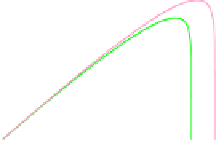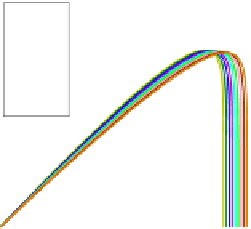Information Technology Reference
In-Depth Information
I
pv
exhibits a linear relationship with light intensity and also varies with tem-
perature.
I
o
is also temperature-dependent [7]. Fig.1 shows that the MPP is
unique in specific conditions. That means different light intensity and tempera-
ture will lead to different MPP.
I−P
U−I
200
12
G=300
G=400
G=500
G=600
G=700
G=800
G=900
G=1000
G=1100
G=300
G=400
G=500
G=600
G=700
G=800
G=900
G=1000
G=1100
180
10
160
140
8
120
100
6
80
4
60
40
2
20
0
0
0
5
10
15
20
25
0
1
2
3
4
5
6
7
8
9
10
Array Current(A)
Array Voltage(V)
(a)
I−P
U−I
100
7
T= 5¡æ
T=10¡æ
T=15¡æ
T=20¡æ
T=25¡æ
T=30¡æ
T=35¡æ
T=40¡æ
T=45¡æ
T= 5¡æ
T=10¡æ
T=15¡æ
T=20¡æ
T=25¡æ
T=30¡æ
T=35¡æ
T=40¡æ
T=45¡æ
90
6
80
5
70
60
4
50
3
40
30
2
20
1
10
0
0
0
1
2
3
4
5
6
0
5
10
15
20
25
Array Current(A)
Array Voltage(V)
(b)
Fig. 2.
I-P and V-I curves under different light intensity(a)and temperature(b)
Fig.2 shows the I-P and V-I characteristics for different values of light inten-
sity and temperature. As shown in Fig.2 (a) the maximum power increases with
increasing light intensity. On the other hand, Fig.2 (b) shows that the maximum
power is little influenced by the sharp increase of temperature in natural envi-
ronment, and also indicates that the output voltage exhibits an inverse relation
with temperature.
Consider the uniqueness of the MPP in different atmospheric conditions, the
T-G-P model which presents the effects of temperature and light intensity on
MPP is discussed. Fig.3 reveals that the change of light intensity exerts a greater
influence on the MPP compared with that of temperature. By using the tool







































































































































































Search WWH ::

Custom Search